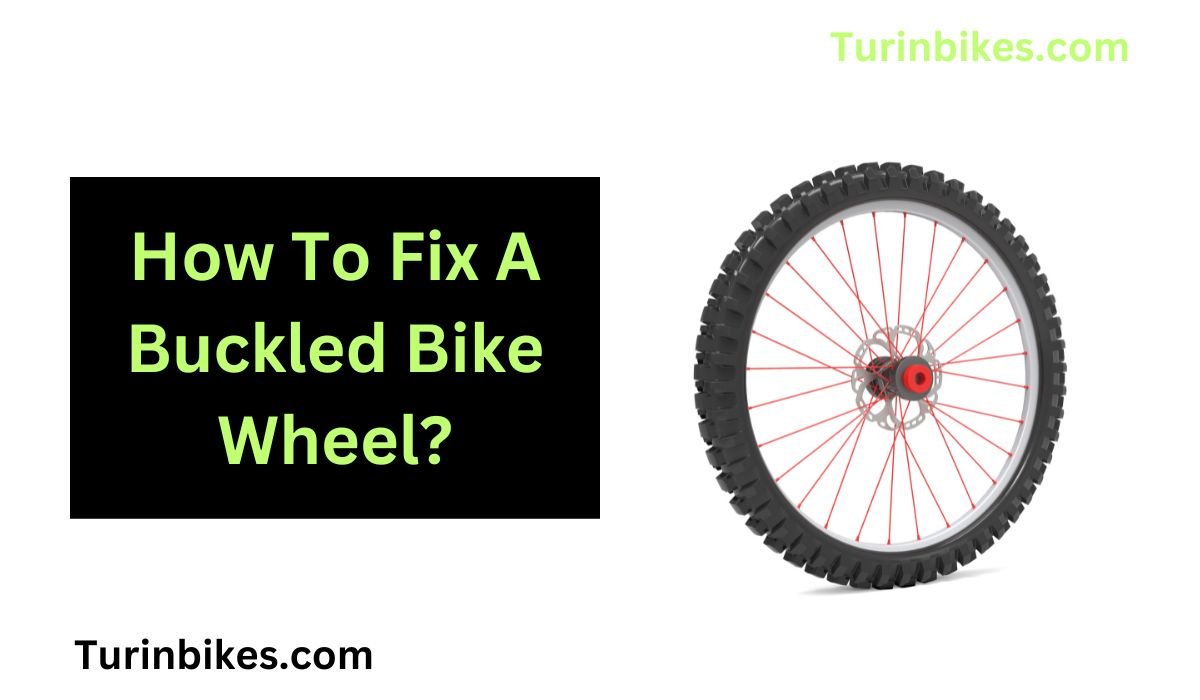
Have you ever found yourself staring at a buckled wheel, wondering how to restore its former glory? You’re not alone! Every mountain bike enthusiast has faced this challenge at some point. “How To Fix A Buckled Bike Wheel?” is a question that often pops up in the cycling community. The process, known as truing, involves adjusting the rim and carefully tightening the spokes. With the proper guidance, you can master this skill and ensure your bike rides smoothly again. Join us as we delve into the captivating world of wheel repair, offering step-by-step insights to get you back on track. Let’s roll!

How To Fix A Buckled Bike Wheel? Step By Step Guide
Turn the bicycle upside down: Every cyclist knows the initial step to most bike maintenance tasks: turn the bicycle upside down, resting it on its handlebars and saddle. This position offers an unobstructed view and access to the wheel, ensuring you can work on it efficiently. It’s an essential step, especially when aiming to fix a buckled wheel, a common issue that can significantly affect the performance of your bike.
Identify the buckled area: Keenly observe its movement as you spin the wheel. Look for areas where it wobbles or where it might touch the brake. Identifying the exact location of the buckle is crucial. If the buckled area isn’t addressed promptly, a wheel can ruin your ride. Whether you’re a casual cyclist or an MTB enthusiast, ensuring your wheel is true is vital for a smooth ride.
Work on the spokes: Armed with a spoke key, a tool no cyclist should be without, begin adjusting the spokes. If the wheel is bent towards the left, you’ll need to tighten the spokes on the right side. This is done by turning the spoke nipple clockwise. Conversely, loosen the left ones. This process, known as truing a wheel, is essential to pull the rim back into its proper alignment. It’s an easy-to-follow method but requires patience and precision.
Spin the wheel to assess: Give the wheel another spin after making the necessary adjustments. The true performance of your bike is heavily reliant on the wheel’s alignment. If you notice it’s still badly buckled, it might be time for a more in-depth wheel truing session. Consider using a wheel jig or a truing stand for a more accurate fix. If you’re unsure, never hesitate to visit your local bike shop for expert advice.
Take a test cycle: Post-adjustment, it’s essential to take your bike out for a test ride. This will help you gauge if the wheel runs smoothly and if your adjustments were successful. If any issues persist, it might be wise to consult a bike shop. Remember, while many cyclists love the DIY approach, sometimes, especially when the wheel is bent severely, seeking expert help ensures both the longevity and safety of your ride.
Final Thoughts: How To Fix A Buckled Bike Wheel
In conclusion, rectifying a buckled bike wheel is truly transformative for avid cyclists. It’s not merely about enhancing the ride’s fluidity; it’s a paramount step towards ensuring safety and optimizing your bicycle’s performance. With a dash of perseverance and finesse, this art can be mastered. However, should uncertainties arise, esteemed local bike establishments stand ready to assist. So, maintain those wheels in impeccable alignment and embark on your journeys with renewed zeal and exhilaration. Pedal on with panache!
What is a buckled wheel?
A buckled wheel on a bicycle is one that has deformities in its rim or spokes causing it to not be perfectly straight and round in shape. This can make riding difficult and put additional stress on the wheels.
How to fix a buckled bike wheel at home:
Identify where the deformation is occurring. Spin the wheel slowly and look where it is wobbling.
If the rim is buckled, you may be able to straighten it by applying firm, even pressure along the curve. Do this incrementally checking if the wheel spins straighter.
If a spoke or spokes are loose, damaged or not evenly tensioned, you can true the wheel by tightening and loosening individual spokes in quarter turns. Repeat this, checking straightness, until the wheel spins evenly.
How to straighten a buckled bike wheel:
Gently applying pressure along the buckled point of the rim or adjusting spoke tension can help straighten a buckled wheel. Spin the wheel periodically checking progress. Stop if the wheel feels like it may break rather than bending back into shape.
Can you unbuckle a bike wheel?
Yes, in many cases buckling is not permanent damage and wheels can be unbuckled or restored to a straighter, more rideable condition. Whether at home or the bike shop, inspect and adjust spoke tension and rim curvature methodically until the wheel is adequately straightened.
Wheel buckled when I squeezed spokes:
Applying too much lateral force to spokes can lead them to buckle the wheel. The spokes and often the rim may now be bent. Try adjusting tension of affected spokes and those adjacent to bring the wheel into proper shape again. If issues persist, take it to a bike shop for potential replacement.
How to put back wheel on bike upside down:
Flipping your bike over risks scratching handlebars or seat. For rear wheels, it’s easier to simply face the side you’ll be working on upwards as you crouch or lean over the bike. Make sure the wheel axle fully seats into both dropouts, thread the nuts on evenly, then rotate for a test spin.
Can all types of bike wheels be fixed the same way?
The basic principles of fixing buckled bike wheels are similar, but the specifics can vary, especially between standard and disc brake wheels or different spoke patterns.
Should I attempt to fix a buckled bike wheel if I’m inexperienced?
If you’re inexperienced, it’s advisable to learn the basics or consult a professional. Improperly adjusted spokes can lead to further damage.
How important is spoke tension when fixing a buckled bike wheel?
Spoke tension is crucial. Uneven tension can cause the wheel to buckle, so it’s important to adjust the tension evenly across the wheel.
Can I fix a severely buckled bike wheel or should I replace it?
Minor buckles can often be fixed, but severely buckled wheels, especially those with damaged spokes or rims, might need to be professionally repaired or replaced.
Meet Sachin Kumar, an avid cyclist and bike enthusiast with a passion for two-wheeled adventures. At our Turinbikes site, Sachin shares expert insights, thrilling ride experiences, and tips for fellow bike lovers.






